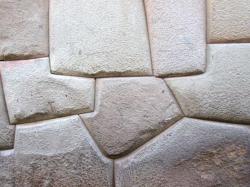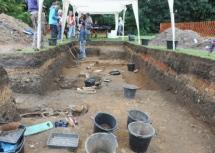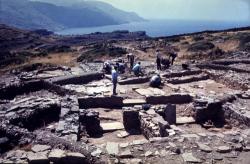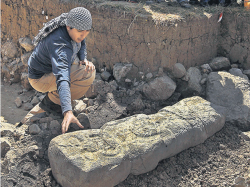INSTITUT SUPERIEUR D'ANTHROPOLOGIE
INSTITUTE OF ANTHROPOLOGY
ONLINE COURSES / COURS A DISTANCE
FALL TERM : OCTOBER 2013
REGISTER NOW
PEROU –  Paredones - Excavators digging at the archaeological site in Paredones, in Nazca province, have discovered a number of Inca-style stone walls, a find that has some researchers very excited. Prior to this discovery, archaeologists had never found Cusco-style stone construction on the coast. As El Comercio reports, most ancient buildings along the Peruvian coastline were made of adobe. However, the walls at Paredones are unique: they combine a base of specially chiseled and perfectly shaped stones with adobe walls. Giuseppe Orefici, the director of the dig, told El Comercio that the Cusco-style construction wasn’t just a happy coincidence. “We can confirm that we’re dealing with specialist carvers that were specially brought from Cusco to do this job and raise these walls,” he said. According to El Comercio, the stones may have been brought from a quarry in the highlands just for this construction. “This is the only case of carved stones that we’ve found on the coast that form a structure similar to what exists in Machu Picchu,” Orefici continued. El Comercio reports that the area was probably an administrative and ceremonial center that would have been used in the last years of the Inca Empire. Orefici also revealed that they’ve discovered the tomb of an important figure, a man of around 40. According to El Comercio, offerings near the tomb and other evidence found at the site indicate that high-ranking elites may have occupied this site at one time.Paredones was inhabited between 1470 and 1550 AD, reports El Comercio.
Paredones - Excavators digging at the archaeological site in Paredones, in Nazca province, have discovered a number of Inca-style stone walls, a find that has some researchers very excited. Prior to this discovery, archaeologists had never found Cusco-style stone construction on the coast. As El Comercio reports, most ancient buildings along the Peruvian coastline were made of adobe. However, the walls at Paredones are unique: they combine a base of specially chiseled and perfectly shaped stones with adobe walls. Giuseppe Orefici, the director of the dig, told El Comercio that the Cusco-style construction wasn’t just a happy coincidence. “We can confirm that we’re dealing with specialist carvers that were specially brought from Cusco to do this job and raise these walls,” he said. According to El Comercio, the stones may have been brought from a quarry in the highlands just for this construction. “This is the only case of carved stones that we’ve found on the coast that form a structure similar to what exists in Machu Picchu,” Orefici continued. El Comercio reports that the area was probably an administrative and ceremonial center that would have been used in the last years of the Inca Empire. Orefici also revealed that they’ve discovered the tomb of an important figure, a man of around 40. According to El Comercio, offerings near the tomb and other evidence found at the site indicate that high-ranking elites may have occupied this site at one time.Paredones was inhabited between 1470 and 1550 AD, reports El Comercio.
http://www.peruthisweek.com/news-archaeologists-discover-inca-ruins-in-nasca-peru-100924
ROYAUME UNI –  Clare Castle Country Park - A second archaeological dig in the space of four months at Clare Castle Country Park has thrown up conclusive evidence of a Christian cemetery containing some of the earliest residents of the town. Three sets of human remains; one a completely intact skeleton, another a skeleton without a head and with an arm lying just a few inches away and the other remains a set of bones were all found in a single trench dug where the railway station used to be. The fact that the bodies were laid out east to west, with no personal belongings in the graves, signifies that they were Christian burials. The unearthing of Thetfordware pottery in the trench - made between 850AD and 1100AD - also enabled archaeologists to more accurately date what they had found. Although no church was found, what was revealed were the remains of a wall that cut through the graves - resulting in the head being knocked off one of the skeletons - a female. Evidence also suggests a rubbish pit was dug between two of the graves - the most likely cause of the arm being removed from the same skeleton. The wall, added Dr Lewis, may be to do with the castle rather than the cemetery.
Clare Castle Country Park - A second archaeological dig in the space of four months at Clare Castle Country Park has thrown up conclusive evidence of a Christian cemetery containing some of the earliest residents of the town. Three sets of human remains; one a completely intact skeleton, another a skeleton without a head and with an arm lying just a few inches away and the other remains a set of bones were all found in a single trench dug where the railway station used to be. The fact that the bodies were laid out east to west, with no personal belongings in the graves, signifies that they were Christian burials. The unearthing of Thetfordware pottery in the trench - made between 850AD and 1100AD - also enabled archaeologists to more accurately date what they had found. Although no church was found, what was revealed were the remains of a wall that cut through the graves - resulting in the head being knocked off one of the skeletons - a female. Evidence also suggests a rubbish pit was dug between two of the graves - the most likely cause of the arm being removed from the same skeleton. The wall, added Dr Lewis, may be to do with the castle rather than the cemetery.
http://www.haverhillecho.co.uk/news/latest-news/more-evidence-of-a-christian-cemetery-in-clare-1-5503175
GRECE –  Zagora - Australian archaeologists will try to solve the ancient mystery of why a bustling early Iron Age city in Greece was abandoned and whether a lack of fresh water was the cause. They're off to Zagora, a city that was thriving with farming and industry on the island of Andros in the 9th century BC before it was inexplicably abandoned. That was about the time of Homer and before Sparta and the Athenian democracy. Australia's first archaeological dig in Greece was at Zagora in the 1960s and 1970s and they managed to excavate about 10 per cent of the 6.5 hectare site but did not solve the riddle. Now 50 Australians will begin working there again next week, hoping to finally explain why an entire population would leave a city at the heart of a major sea trading route. Ground-penetrating radar, satellite imaging analysis and multi-spectral treatment of those images might help, says one of the dig's co-directors, Lesley Beaumont from Sydney University's Department of Archaeology. "What we are able to do now, which couldn't even have been dreamed of back then, is to use subsurface testing methods ... to look underneath the surface of the ground before even putting a spade into it," she told AAP. They are curious about whether hydrology might have something to do with the abandonment of the settlement that had been growing at an extraordinary rate. With three years of funding they began last year with big picture analysis and geophysical survey with help from a geologist. This year includes satellite imagery work, aerial photography and a full excavation season from September 23 until November 4.
Zagora - Australian archaeologists will try to solve the ancient mystery of why a bustling early Iron Age city in Greece was abandoned and whether a lack of fresh water was the cause. They're off to Zagora, a city that was thriving with farming and industry on the island of Andros in the 9th century BC before it was inexplicably abandoned. That was about the time of Homer and before Sparta and the Athenian democracy. Australia's first archaeological dig in Greece was at Zagora in the 1960s and 1970s and they managed to excavate about 10 per cent of the 6.5 hectare site but did not solve the riddle. Now 50 Australians will begin working there again next week, hoping to finally explain why an entire population would leave a city at the heart of a major sea trading route. Ground-penetrating radar, satellite imaging analysis and multi-spectral treatment of those images might help, says one of the dig's co-directors, Lesley Beaumont from Sydney University's Department of Archaeology. "What we are able to do now, which couldn't even have been dreamed of back then, is to use subsurface testing methods ... to look underneath the surface of the ground before even putting a spade into it," she told AAP. They are curious about whether hydrology might have something to do with the abandonment of the settlement that had been growing at an extraordinary rate. With three years of funding they began last year with big picture analysis and geophysical survey with help from a geologist. This year includes satellite imagery work, aerial photography and a full excavation season from September 23 until November 4.
http://news.ninemsn.com.au/technology/2013/09/19/12/51/aussie-archaeologists-off-to-zagora
TURQUIE –  Hadrianaupolis - The ancient city of Hadrianaupolis, which is often described as the “Zeugma of the Black Sea region” because of the mosaics unearthed there, is expected to become a Christian pilgrimage center when its current works are completed, according to officials. The ancient city is located in the Black Sea province of Karabük. Karabük Provincial Culture and Tourism Director İbrahim Şahin said a 12-person team, including experts from Germany and Austria, were working to examine the underground in the ancient city. “German researchers working in this area have said that the Christian world will show an interest there. [So] when the works are completed, it will open to tourism, becoming a pilgrimage center. The church in the ancient city will be covered and the mosaics in it will be displayed, ” Şahin said.
Hadrianaupolis - The ancient city of Hadrianaupolis, which is often described as the “Zeugma of the Black Sea region” because of the mosaics unearthed there, is expected to become a Christian pilgrimage center when its current works are completed, according to officials. The ancient city is located in the Black Sea province of Karabük. Karabük Provincial Culture and Tourism Director İbrahim Şahin said a 12-person team, including experts from Germany and Austria, were working to examine the underground in the ancient city. “German researchers working in this area have said that the Christian world will show an interest there. [So] when the works are completed, it will open to tourism, becoming a pilgrimage center. The church in the ancient city will be covered and the mosaics in it will be displayed, ” Şahin said.
http://www.hurriyetdailynews.com/ancient-city-to-become-a-center-for-christianity.aspx?pageID=238&nID=54667&NewsCatID=375
PEROU –  Pacopampa - A joint Peruvian and Japanese team of archaeologists excavating at the Pacopampa archaeological site in Cajamarca have found a 250 kilogram carved stone monolith.The monolith, which features the striking image of a half-man, half-jaguar, was discovered buried in the Pacopampa archaeological complex. El Comercio reports that the carving is in excellent condition, and archaeologists involved in the project are currently investigating options for its continued preservation. Japanese archaeologist Yuji Seki, the director of the dig, told El Comercio that the monolith was probably a way for the government of the region to communicate their divine power and ideology to the people they ruled. Seki suggested that the anthropomorphic feline design carved on the monolith is meant to represent the power of a priest or priestess whose mystical abilities included being able to communicate with animals. El Comercio reports that though the monolith is unique, it shares important characteristics with other famous finds. Both the Raimondi Stela and the Tello Obelisk from the temple at Chavín de Huantar feature a similar anthropomorphic figure. According to El Comercio, the monolith originally stood at the entrance to the temple. However, when the Cajamarca culture replaced the original inhabitants of Pacopampa, they buried the monolith. Seki points out that this would have been a sign of fear and respect towards the artifact. In 2009, Seki was also part of the team that discovered the tomb of the Lady of Pacopampa. Archaeologists hypothesize that powerful priestesses may have ruled the area at one point. Until they are able to properly transport and preserve the carving, the team at Pacopampa is planning to re-bury the monolith in order to protect it.
Pacopampa - A joint Peruvian and Japanese team of archaeologists excavating at the Pacopampa archaeological site in Cajamarca have found a 250 kilogram carved stone monolith.The monolith, which features the striking image of a half-man, half-jaguar, was discovered buried in the Pacopampa archaeological complex. El Comercio reports that the carving is in excellent condition, and archaeologists involved in the project are currently investigating options for its continued preservation. Japanese archaeologist Yuji Seki, the director of the dig, told El Comercio that the monolith was probably a way for the government of the region to communicate their divine power and ideology to the people they ruled. Seki suggested that the anthropomorphic feline design carved on the monolith is meant to represent the power of a priest or priestess whose mystical abilities included being able to communicate with animals. El Comercio reports that though the monolith is unique, it shares important characteristics with other famous finds. Both the Raimondi Stela and the Tello Obelisk from the temple at Chavín de Huantar feature a similar anthropomorphic figure. According to El Comercio, the monolith originally stood at the entrance to the temple. However, when the Cajamarca culture replaced the original inhabitants of Pacopampa, they buried the monolith. Seki points out that this would have been a sign of fear and respect towards the artifact. In 2009, Seki was also part of the team that discovered the tomb of the Lady of Pacopampa. Archaeologists hypothesize that powerful priestesses may have ruled the area at one point. Until they are able to properly transport and preserve the carving, the team at Pacopampa is planning to re-bury the monolith in order to protect it.
http://www.peruthisweek.com/news-archaeologists-find-ancient-jaguar-monolith-in-northern-peru-100850
INDE –  Delhi - Restoration work has been completed at Humayun’s Tomb, a 16th-century Unesco World Heritage site in Delhi that inspired other Mughal architecture, including the Taj Mahal. Unesco says Humayun’s Tomb is of particular cultural significance as it was the first garden-tomb on the Subcontinent and exemplifies the formative stage of Mughal architecture. Humayun was India’s second Mughal emperor. His widow, Biga Begum, arranged for the tomb to be built in 1569-70, 14 years after his death. Other members of the ruling family were later buried there and the site contains around 150 graves, Unesco says. “It is the first of a long series of dynastic tombs and innovative in a number of ways, notably by virtue of the fact that it introduced the garden tomb to the Subcontinent,” Unesco said. The Taj Mahal in Agra was built by Mughal emperor Shah Jahan for his wife, between 1631 and 1648. “Humayun had travelled widely in the Islamic world, notably in Persia and central Asia, and brought back with him ideas that were applied by the architect of his tomb,” Unesco added. Video of the restoration work at Humayun’s Tomb: http://www.youtube.com/watch?v=zh3PLA2qVXE
Delhi - Restoration work has been completed at Humayun’s Tomb, a 16th-century Unesco World Heritage site in Delhi that inspired other Mughal architecture, including the Taj Mahal. Unesco says Humayun’s Tomb is of particular cultural significance as it was the first garden-tomb on the Subcontinent and exemplifies the formative stage of Mughal architecture. Humayun was India’s second Mughal emperor. His widow, Biga Begum, arranged for the tomb to be built in 1569-70, 14 years after his death. Other members of the ruling family were later buried there and the site contains around 150 graves, Unesco says. “It is the first of a long series of dynastic tombs and innovative in a number of ways, notably by virtue of the fact that it introduced the garden tomb to the Subcontinent,” Unesco said. The Taj Mahal in Agra was built by Mughal emperor Shah Jahan for his wife, between 1631 and 1648. “Humayun had travelled widely in the Islamic world, notably in Persia and central Asia, and brought back with him ideas that were applied by the architect of his tomb,” Unesco added. Video of the restoration work at Humayun’s Tomb: http://www.youtube.com/watch?v=zh3PLA2qVXE
http://blogs.wsj.com/indiarealtime/2013/09/18/before-the-taj-mahal-there-was-this/